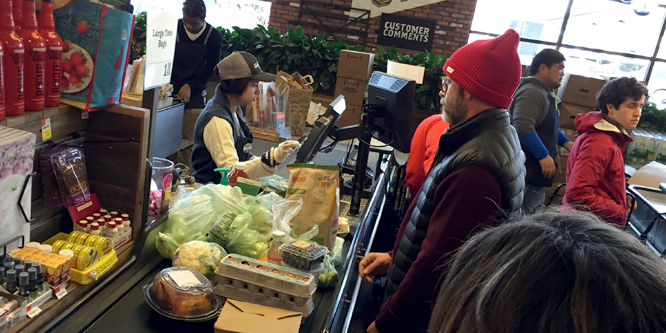
Photo: RetailWire
September 5, 2019
Whole Foods wants a hand from shoppers at checkout
If Amazon implements its latest high-tech checkout innovation at Whole Foods, customers won’t need to pull out a credit card — a wave of the hand will do the trick. The solution uses hand-based identification to facilitate payment.
The hand-based payment technology is quietly being piloted at Amazon’s New York offices, according to an article in the New York Post. To pay with the technology, a user places a hand in front of a reader and, if recognized, the system charges a corresponding credit card. Unlike fingerprint recognition hardware, the new technology does not require a user to press skin against the reader for it to be recognized, but instead uses computer vision and “depth geometry” to read the unique characteristics of the hand.
The main draw is speed, with the hand scanner reputedly able to complete a transaction in a few hundred milliseconds vs. credit card transaction’s three to four seconds. Amazon plans to begin piloting the solution in a handful of Whole Foods stores at the beginning of next year and foresees an eventual rollout to all store locations.
The technology could speed the checkout process while offering some advantages over similar controversial technology trending abroad.
In China, “Pay By Smile” has been growing in popularity as big tech vendors like Alipay and Tencent have begun rolling out their own solutions, according to The Guardian. Using facial recognition to pay, however, raises concerns about privacy, state surveillance and data security that does not sit well in North America. In the U.S. and Canada, retailers that have piloted the use of facial recognition for things like smart coolers have faced blowback from privacy and consumer advocates.
Identifying a hand, rather than a face, would seem at least at first blush to be a less invasive way of automatically recognizing a customer.
There could be some hurdles to hand recognition working cost-effectively at scale, though. The technology is currently only accurate to one ten-thousandth of 1 percent, according to the Post article. Amazon.com engineers are working to reduce that to a millionth of one percent before going live.
Discussion Questions
DISCUSSION QUESTIONS: What advantages/disadvantages might hand recognition have over other methods of enhanced checkout? What does the development of this technology say, if anything, about the efficacy of other options Amazon has been working on, like “Just Walk Out”?
Poll
BrainTrust
Lisa Goller
B2B Content Strategist
Recent Discussions








I think this is an innovative solution that is easy for the customer; hopefully it will eventually become more secure, which is a critical ingredient in terms of making consumers confident in using it. I also think it avoids many of the concerns around privacy that seem to be attached to payment by facial recognition.
Hand recognition is but another method of identifying the customer. New technology yes, but not revolutionary and not a must have. Customers: don’t forget to take off at least one glove in the winter (not you Floridians).
I think for the average consumer, scanning a body part vs. using a card/phone/watch crosses a privacy line. Unlike the Go concept, there is something invasive about this.
From a practical perspective, I’m not sure what benefits hand scanning provides: no one is going to leave their phone/purse/wallet in the car. The challenge of making lines shorter isn’t really a question of milliseconds to seconds for payment. It will take a typical shopper longer than that to figure out where to put their phone in order to scan their hand.
Part of me thinks this is another Amazon red herring, i.e., a way to put the focus on something new and innovative, to take focus away from other activities or to get competitors to waste time and money chasing a similar “solution.”
I don’t think this one will pass the consumer sniff test. You want my HAND print? no.
Also, given that Whole Foods Market is using the old-fashioned self checkout rather than the highly touted (and in my mind, very questionable) Amazon Go, I think that tells us there is a real wall between theory (and FUD for the rest of the retail community) and practice.
Mind you, I don’t think self checkout is such a great idea for Whole Foods Market either, sort of goes against the brand identity, but I did go to my local Whole Foods and actually use it the other day.
As with other retailers, the number of cashiers is reduced, so if you want to get out quickly you use self checkout. This is not my favorite practice in the world, but it’s certainly being done by a lot of them.
Uhhhhhhhh. Excuse me for yawning. This is nothing. It’s not a new technology and the reality about increasing checkout speed has nothing to do with shaving three to four seconds. A speedier checkout can be achieved by things like:
More available cashiers to operate registers (often Whole Foods has lines 10 or more people deep);- Eliminating cashiers needing to look up item codes;
- Cashiers with more product knowledge that don’t have to ask things like “Is this bok choy?”;
- More baggers;
- For real fast checkout… RFID, especially whole cart scanning RFID.
Likely there is some other end game that Amazon is not disclosing, like taking ownership of the checkout device and eliminating card terminal fees or similar.
We have to give credit to Amazon for taking the initiative in developing new and faster ways to get us through the shopping experience. From Amazon Go to now hand waving at the register shows this company is all about advanced technology. The significant benefit is for the customer, and that is speed. We get frustrated with the lines at the registers and retailers have tried numerous alternatives, but none are quite good enough. That said, we as a society have gotten used to more and more speed with being able to quickly stream something on our Smart TVs as well as being able to drive through faster EZpass lanes. It’s about speed and convenience. Whether we end up with retina scans, smile scans, or in this case a wave, it shows that technology continues to pave the way of a new world interested in convenience and instant gratification.
Seems like a lot of effort and expense in order to save three to four seconds. Three to four seconds — really?
I think this falls more into the category of “just because we can doesn’t mean we should.” When I think about grocery shopping, the payment process is the least of my problems with the path to purchase. I think resources could be spent in more impactful ways to improve overall convenience. Whose problem is this solving and how much friction is being added vs. eliminated? Swiping a card is not difficult or an encumbrance on the purchasing process. Scan and go is likely as far as they will get at scale.
Well stated Casey. Waving your hand will not fundamentally eliminate all the other heavy friction points at Whole Foods. People have already embraced all of the other flexible and secure payment options.
The Amazon Go Just Walk Out approach is probably the longer-term strategy, however that will take plenty of time to scale, especially as there are so many more complexities to account for with the larger operation.
This pilot proves smart technology has emerged as a retail priority.
American consumers now expect speed and convenience in stores, including shorter checkout times. Hand recognition makes sense in grocery, as shoppers may make two or more shopping trips per week for fresh, organic foods.
Whole Foods’ audience of upscale, educated, urban consumers – including tech-savvy younger shoppers – may be more willing to use hand recognition technology to finish their shopping trip faster. Speed could outweigh their privacy and data collection concerns.
Meanwhile, Amazon/Whole Foods gathers richer data on in-store shoppers to aggregate with the retailers’ e-commerce data to improve personalized service. Piloting hand recognition technology also gives Whole Foods a competitive advantage in the fiercely competitive grocery and mass channels, and helps to bridge the gap with China’s sophisticated retail technology, like the facial recognition used in stores like Hema.
Hand recognition would be faster than credit cards which are now taking longer than they used to. I use my Apple Watch at any place that takes it. It is not only more convenient, it processes the credit transaction much more quickly. While my Apple Watch is completely accurate, it sounds like Amazon has work to do before hand recognition is completely accurate. The advantage of Amazon’s “Just Walk Out” is if the item scan misses an item, Amazon takes the hit. WIth hand recognition not being completely accurate, the customer takes the hit on a mistaken hand recognition.
While this may remove a bit of friction during the checkout process, it’s not a gamechanger that’s going to mitigate the long lines at your local Whole Foods or the confusion in identifying if you bought dill or Italian parsley. Customers have already embraced other more seamless and secure methods of payments, including Apple Pay, Google Pay etc., and this represents another option.
This is an incremental enhancement and not a solution to the other more friction-filled moments of the checkout process at Whole Foods.
I do not believe there is anything special or unique in this technology or its implementation at retail. What I do believe is that in the next X years, there will be new technologies that essentially eliminate the cashier and make checkout more efficient.
If I were to vote it would be for “Just Walk Out,” but technology is moving so quickly that the reality is probably beyond my current imagination.
It is always fun to see what new techniques are being tested. Personally I do think that scanning hands is less invasive than scanning faces and I can see people liking not having to fish their cards out. The thing is, the consumer will have to sign up for this somewhere and that is when the less tech-savvy people start getting fidgety. I just helped my brother-in-law set up finger scan on his phone and it took forever. He didn’t get just putting his thumb on the button. Plus he didn’t like it. Trial and error is what it’s about in these things and I’m happy to see Whole Foods trying. For my 2 cents.
What the article doesn’t mention is the fact that consumers need to first set up their scan and attach it to their credit card while in a Whole Foods store. The set-up process will prevent a lot of people from participating and it is still a little creepy letting a company have a scan of your hand.
I prefer Apple Pay as a convenient payment option, until something “better” comes along.
So will this hand thing make it even more of an impersonal interaction at a noted and expected “better” grocery store? And if it does, what steps will Whole Foods take to appear at least as caring and attentive as ever?
This technology has been around, in some shape or form, for a long time. I do think it crosses privacy lines for most customers. In reality, since Amazon (or any other retailer) has your credit card on file, we should be more concerned about keeping our credit card data safely locked away. If Amazon really wants to speed up the checkout they should concentrate on other less technical things to help move folks through the checkout process faster.
First, anything that saves time at checkout is good for both the shopper and the retailer. In payment seconds matter, just like mobile app performance and web page refreshes. A few seconds multiplied by hundreds of transactions a day turns into real time saved for the retailer, more people checked out per hour, and potentially shorter lines. Arguably, there is an even greater impact to customer experience when the customer is most anxious to get out of the store.
Second, I am not sure that hand recognition is any better or worse than any other payment identification and validation technique, just something new to try, one new idea in the constant pursuit of innovation to drive better results. I applaud Whole Foods for continuing to try new things in search of the right experience, cost, and result.
Consumers may say “just forget it.” Aiding and abetting Amazon’s ambitions to “manage” the privacy of individual consumers is just one more step to an Amazon-monitored life for us humans. Alexa, are you listening? Today we found out Facebook, who held 80 million of our phone numbers on an unsecured server, did not even have to be hacked for someone to post 80 million of our phone numbers online. Piece by piece, facial recognition, finger recognition, hand recognition, in-home monitoring of conversations by always-on, even if turned off, digital devices, privacy given up in the name of convenience? Just say forget it!
Cynthia, excellent point. It is absolutely feasible that either via consent to multiple entities or even one entity like Amazon, or via nefarious actors, extremely detailed personal info can be assembled into a profile that is irrevocable and potentially invasive or dangerous. No one can reset their biometrics.
I believe this is a much less intrusive way to identify customers and a far more privacy oriented than fingerprint or facial recognition. In the grocery segment, it’s all about speed to checkout. If they can reduce the checkout time that is a big win for grocery and likely to be a big win for all types of retail. Retail is all about peak. How fast do the lines move the day after Thanksgiving? How many walkouts did I save?
This technology speeds checkout. If I can do that then I can increase the likelihood of a good customer moment, which leads to a happy customer and lifetime value (LTV) and recency of purchase, frequency of purchase or visit and monetary value of the customer (RFM). The true measure of CRM.
I love this! Once again, Amazon is baking convenience into the customer experience. Technology is creating an easier, more convenient, and friction-less experience. Customers love convenience!
We Americans are indeed far more sensitive to biometric security/payment technology than most other cultures. However, I can tell you that we do, in fact grow more and more comfortable if these technologies are convenient and effective. If you feel this tech encroaches on your privacy concerns, do you also feel that same way about the fingerprint sensor to unlock your smartphone, or the personal search tracking virtually all major search engines employ?
Take a deep breath, calm down, and let the tech do what we want it to do. Any time you use your credit card, you have the potential for the data to be stolen. Bottom line, use cash, a wired landline and stay off the internet if you don’t want to be tracked. That worked just fine for all of us only a few short decades ago. I think I was less stressed back then.
I still recall the first time I visited a police station. I was on a Cub Scout field trip and the police sergeant pulled out his ink stamp and a small 5×5 card with five boxes for each finger. He demonstrated how to roll the fingers in the ink and then reverse roll it onto the card. He then mentioned that this fingerprint lasts forever and it tells us who the bad guys are.
Giving this kind of power to a corporation who then digitizes the same data that goes into your passport, the same fingerprint you use to open your iPhone and modern laptops will be a challenge for later generations, and will be scary for the current gen who know their identity is closely tied to their biometrics.
For Amazon/Whole Foods the game is deeper embedding into the private lives of consumers. The trade off of 3-4 seconds of convenience doesn’t justify the risk.
It’s never surprising to hear about Amazon experimenting. This isn’t exactly super new technology, although I expect that Amazon is testing it with other use cases in mind as well. I can imagine that some people may be more comfortable with this than facial recognition, but I wonder if it really offers any more convenience or efficiency. Is it really going to make a difference to checkout speed? What if the tech struggles to recognise even one hand? Suddenly everything slows down massively.
Also, unless this is the only payment option would be incredibly restrictive, you’re relying on uptake to improve checkout speed. If only one in 10 people, for example, used it to pay is there any benefit? With card and smartphone payments so quick, easy to understand, and accepted by customers I wonder how many will opt for this over them. Maybe useful if you happen to forget or lose your wallet, but otherwise I’m not sure it will become the standard.